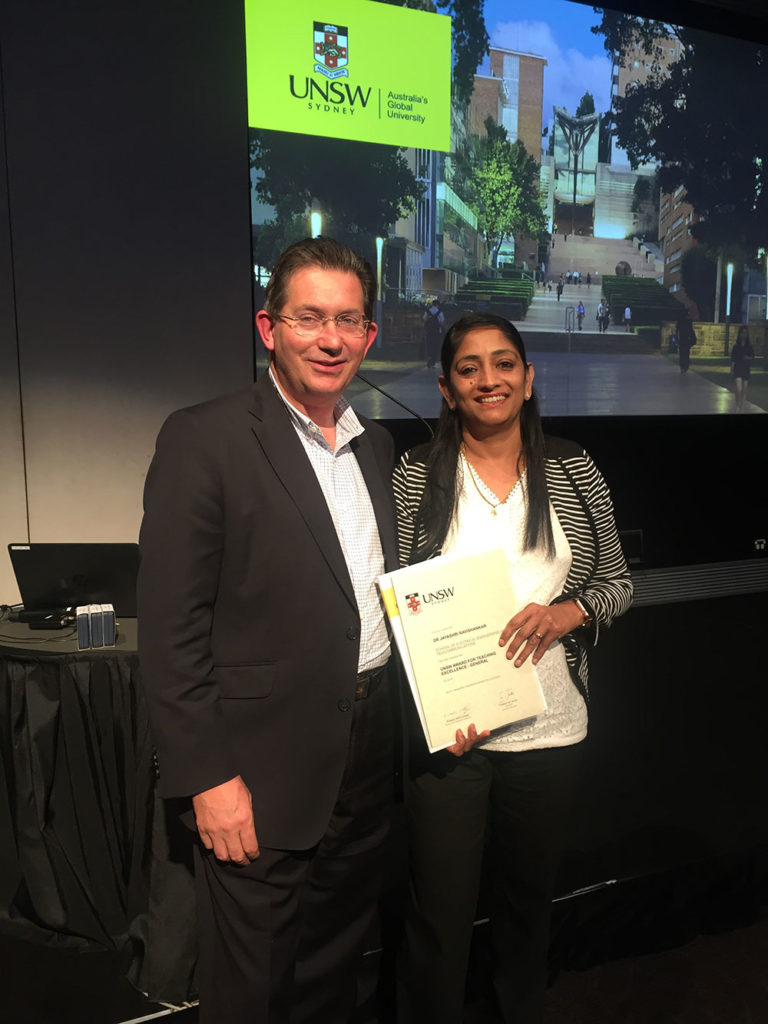A UNSW Engineering Professor with a passion for innovation has been recognised in the 2019 Australian Awards for University Teaching.
When Professor Jayashri Ravishankar stood in front of her first UNSW electrical engineering lecture in 2010, looking out at a cohort of 465 undergraduates came as somewhat of a shock.
“I’d taught for fifteen years in the south of India … [where] there were 70 students in my lectures,” Ravishankar told create.
“It was really overwhelming and I didn’t feel like I had much of a connection with the students … Everything was so anonymous for me, and for the students. That’s when I thought, I should do something about this.”

Inspired to more closely engage with her students, the expert in energy systems has since implemented a range of innovative teaching strategies in her courses, from a ‘flipped teaching’ mode of delivery to virtual reality simulations and ‘blended guest lectures’.
Her endeavours are credited for improved attendance, academic results and student employment among her electrical engineering students, and she was recently recognised with a Citation for Outstanding Contributions to Student Learning through the 2019 Australian Awards for University Teaching.
“I was really proud that I could achieve this in ten years at UNSW,” she said. “It was amazing, although I have a lot more to do.”
Creating connections
For Ravishankar’s students, gone are the days of traditional two-hour lectures. Instead, her flipped teaching model comprises a one-hour discussion session on a topic, followed by students completing online interactive modules in their own time.
Students then attend a group problem-solving session, led by mentors who undertook the course in the previous year.
This approach allows for greater engagement with the content, as well as building connections between students, Ravishankar said.
“I could see the difficulties faced by international students, coming to a new country … [so] I started pulling in mentors for the new students,” she explained.
“The mentors gain leadership [experience], helping the students with their group work, and … for example, [can] even talk to the students about renting a place… In that way it became a great success.”
As well as creating connections between students, Ravishankar’s blended guest lectures also allow for greater connection with industry.
After recording guest lectures either on-site or at UNSW, Ravishankar sets a group assessment piece for her students, whereby they research and develop a presentation on a particular site project. Students then present their findings back to the industry guests in an organised session.
“The students are prepared, and they have a meaningful way to interact with the industry people,” Ravishankar said.
“Otherwise, if you ask an industry person to come and give a lecture, the response of the students might not be as good, because they don’t listen, or don’t turn up. But because it’s part of the assessment, the students do turn up and they’re very happy to present … The industry people give feedback on what they have or haven’t understood, and they [the students] make connections.”
Ravishankar also uses virtual reality (VR) simulations to bring the site experience to her students, an approach she found significantly increased course engagement.
In fact, after introducing VR into the classroom, attendance jumped from 50 per cent to 90 per cent.
“We take a 360-degree shot of the site … [and develop] a virtual walk through,” she said.
“I can then add hotspots in between, for example, a video of an industry person talking in a particular place.”
A focus on graduate skills
Ravishankar’s flipped teaching approach aims to instil greater teamwork and leadership skills in her graduates, attributes she says are increasingly in demand by industry.
“One student was selected for a job because his boss said his graduate skills were at the highest level … [even though] many applicants had better marks on their transcripts,” she said.
“The student came back and told me he was very happy he did my course.”
Swapneel Thite was one of Professor Ravishankar’s students in 2017. He said the teaching model initially took some getting used to, but the benefits quickly became apparent.
“The other courses were more teacher-centric … [whereas] Professor Ravishankar’s learning platform was amazing,” he said.
“It had chunks of five-minute videos so that you didn’t get bored. Each and every topic was covered in that way.”
Inspired by Ravishankar’s innovative teaching practices, Thite recently returned to UNSW after working in industry. He is now completing a PhD in engineering education, focusing on teamwork skills.
“With the technical side [of engineering] there is … so much that you can contribute, but when I look at the education space … the impacts can be amazing,” he said.
“You always have a few tutors or teachers who steer your career or life in a different direction. For me, one of them was Professor Ravishankar.”